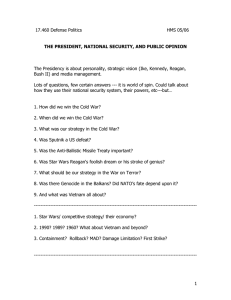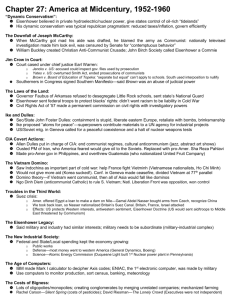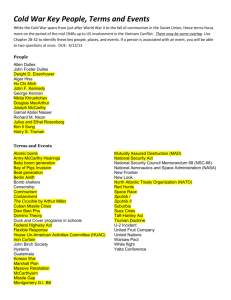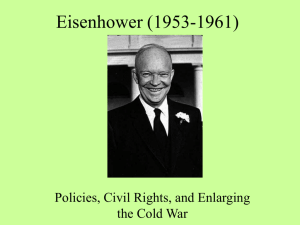– Unit 12, Chapter 37 (13 Ed.)
advertisement
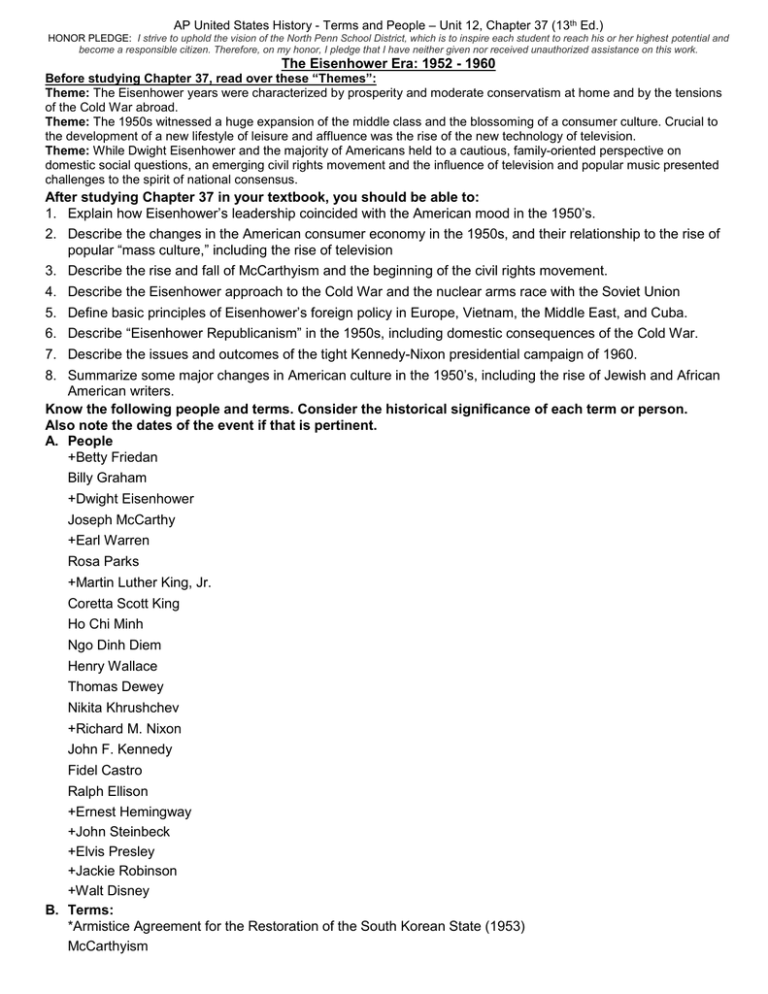
AP United States History - Terms and People – Unit 12, Chapter 37 (13th Ed.) HONOR PLEDGE: I strive to uphold the vision of the North Penn School District, which is to inspire each student to reach his or her highest potential and become a responsible citizen. Therefore, on my honor, I pledge that I have neither given nor received unauthorized assistance on this work. The Eisenhower Era: 1952 - 1960 Before studying Chapter 37, read over these “Themes”: Theme: The Eisenhower years were characterized by prosperity and moderate conservatism at home and by the tensions of the Cold War abroad. Theme: The 1950s witnessed a huge expansion of the middle class and the blossoming of a consumer culture. Crucial to the development of a new lifestyle of leisure and affluence was the rise of the new technology of television. Theme: While Dwight Eisenhower and the majority of Americans held to a cautious, family-oriented perspective on domestic social questions, an emerging civil rights movement and the influence of television and popular music presented challenges to the spirit of national consensus. After studying Chapter 37 in your textbook, you should be able to: 1. Explain how Eisenhower’s leadership coincided with the American mood in the 1950’s. 2. Describe the changes in the American consumer economy in the 1950s, and their relationship to the rise of popular “mass culture,” including the rise of television 3. Describe the rise and fall of McCarthyism and the beginning of the civil rights movement. 4. Describe the Eisenhower approach to the Cold War and the nuclear arms race with the Soviet Union 5. Define basic principles of Eisenhower’s foreign policy in Europe, Vietnam, the Middle East, and Cuba. 6. Describe “Eisenhower Republicanism” in the 1950s, including domestic consequences of the Cold War. 7. Describe the issues and outcomes of the tight Kennedy-Nixon presidential campaign of 1960. 8. Summarize some major changes in American culture in the 1950’s, including the rise of Jewish and African American writers. Know the following people and terms. Consider the historical significance of each term or person. Also note the dates of the event if that is pertinent. A. People +Betty Friedan Billy Graham +Dwight Eisenhower Joseph McCarthy +Earl Warren Rosa Parks +Martin Luther King, Jr. Coretta Scott King Ho Chi Minh Ngo Dinh Diem Henry Wallace Thomas Dewey Nikita Khrushchev +Richard M. Nixon John F. Kennedy Fidel Castro Ralph Ellison +Ernest Hemingway +John Steinbeck +Elvis Presley +Jackie Robinson +Walt Disney B. Terms: *Armistice Agreement for the Restoration of the South Korean State (1953) McCarthyism AP United States History - Terms and People – Unit 12, Chapter 37 (13th Ed.) HONOR PLEDGE: I strive to uphold the vision of the North Penn School District, which is to inspire each student to reach his or her highest potential and become a responsible citizen. Therefore, on my honor, I pledge that I have neither given nor received unauthorized assistance on this work. Army-McCarthy hearings Checkers speech *Senate Resolution 301: Censure of Senator Joseph McCarthy (1954) “creeping socialism” desegregation “massive retaliation” military industrial complex feminism *Brown v. Board of Education (1954) White Citizens Councils *National Interstate and Defense Highways Act (1956) *Executive Order 10730: Desegregation of Central High School (1957) Civil Rights Act of 1957 Montgomery bus boycott Geneva Summit (Accords) - 1954 Hungarian revolt Suez crisis (be able to locate the Suez Canal on a world map) Eisenhower Doctrine Landrum-Griffith Act U-2 incident Sputnik and “Rocket fever” “missile gap” National Defense Education Act St. Lawrence seaway The Feminine Mystique “televangelists” +=One of the 100 Most Influential Americans of All Time, as ranked by The Atlantic. Go to Webpage to see all 100. *=A 100 Milestone Document from the National Archive. Go to Webpage to link to these documents. C. Sample Essay: Using what you have previously learned and what you read in Chapter 38, you should be able to answer an essay such as this one: How did television and other innovations of the “consumer age” affect American politics, society, and culture? D. Voices from the past: “We shall bury you!” Quote from Soviet leader Nikita Khrushchev warning the United States in 1958 that Communism will ultimately prevail over democracy. http://www.newstatesman.com/200010020025 “Until this moment, Senator, I think I never really gauged your cruelty or your recklessness. . . . Have you no decency, sir, at long last? Have you left no sense of decency?” Joseph N. Welch, special counsel for the army at the 1954 Army-McCarthy hearings, speaking to Joe McCarthy. “We come then to the question presented: Does segregation of children in public schools solely on the basis of race, even though the physical facilities and other ‘tangible’ factors may be equal, deprive the children of the minority group of equal educational opportunities? We believe that it does. . . . To separate them from the others of similar age and qualifications solely because of their race generates a feeling of inferiority as to their status in the community that may affect their hearts and minds in a way unlikely ever to be undone. . . . . . . We conclude that in the field of public education the doctrine of ‘separate but equal’ has no place. Separate educational facilities are inherently unequal.” *Chief Justice Earl Warren, from the unanimous opinion in Brown v. Board, May 17, 1954. AP United States History - Terms and People – Unit 12, Chapter 37 (13th Ed.) HONOR PLEDGE: I strive to uphold the vision of the North Penn School District, which is to inspire each student to reach his or her highest potential and become a responsible citizen. Therefore, on my honor, I pledge that I have neither given nor received unauthorized assistance on this work. Voices from the past (continued): “. . . This unwarranted exercise of power by the court, contrary to the Constitution, is creating chaos and confusion in the states principally affected. It is destroying the amicable relations between the white and Negro races that have been created through ninety years of patient effort by the good people of both races. It has planted hatred and suspicion where there has been heretofore friendship and understanding.” From The Southern Manifesto signed by 96 congressmen from the South on March 12, 1956 in response to the Brown decision. G. What impact did the launching of Sputnik have on the United States? Read the following. Sputnik: The Shock of the Century (A new book by Paul Dickson) “Never before had so small and so harmless an object created such consternation.” Daniel J. Boorstin, The Americans: The Democratic Experience "Listen now," said the NBC radio network announcer on the night of October 4, 1957, "for the sound that forevermore separates the old from the new." Next came the chirping in the key of A-flat from outer space that the Associated Press called the "deep beep-beep." Emanating from a simple transmitter aboard the Soviet Sputnik satellite, the chirp lasted three-tenths of a second, followed by a three-tenths-of-a-second pause. This was repeated over and over again until it passed out of hearing range of the United States. The satellite was silver in color, about the size of a beach ball, and weighed a mere 184 pounds. Yet for all its simplicity, small size, and inability to do more than orbit the Earth and transmit meaningless radio blips, the impact of Sputnik on the United States and the world was enormous and unprecedented. The vast majority of people living today, at the beginning of the twenty-first century, were born after Sputnik was launched and may be unaware of the degree to which it helped shape life as we know it. Now is an especially good time to take a fresh and focused look at the event whose impact looms even larger with the passing of time. In the last decade an incredible amount of once-secret material has been declassified and made public. Scholars and writers both inside and outside government have coaxed key Cold War documents out of hiding. Collectively, this material has given new dimensions and twists to almost every aspect of the events leading up to and following the launch of Sputnik. For example, one recently released document reveals evidence of a long-forgotten pre-Sputnik "olive branch" extended by Russian scientists, who asked their American counterparts to supply a piece of scientific equipment for a planned launch. By most indications, this piece of equipment was meant for the third Sputnik. It is not widely known even now that one of the reasons President Dwight D. Eisenhower and those around him did not react with alarm over Sputnik going into space ahead of an American satellite was that Eisenhower welcomed the launch to help establish the principle of "freedom of space." At the time of the Sputnik "crisis," the White House, Central Intelligence Agency, Air Force, and a few highly select and trustworthy defense contractors were creating a spy satellite that was so secret that only a few dozen people knew of it. Even its name, CORONA, was deemed secret for many years. Instead of being concerned with winning the first round of the space race, Eisenhower and his National Security Council were much more interested in launching surveillance satellites that could tell American intelligence where every Soviet missile was located. For many of us born before the 1950s, the fascination and astonishment engendered by the launch of Sputnik remain fresh in our minds. Like many of my generation, I can recall exactly where I was when I heard about Sputnik's launch. I was eighteen years old, a college freshman at Wesleyan University in Middletown, Connecticut. A friend stopped me in the middle of the campus to say that he had heard about it on the radio. Instinctively, we both looked up. Within hours I would actually hear its signal rebroadcast on network radio. Before the weekend was over, I got to hear it directly on a shortwave radio as it passed overhead. Not only could you hear Sputnik, but, depending on where you were, it was possible to see it with the naked eye on certain days in the early morning or the late evening when the sun was still close enough to the horizon to illuminate it. While standing in the middle of the college football field a week or so after the launch, I first saw the satellite scooting across a dark evening sky orbiting the Earth at a speed of 18,000 miles per hour. Watching Sputnik traverse the sky was seeing history happen with my own eyes. To me, it was as if Sputnik was the starter's pistol in an exciting new race. I was electrified, delirious, as I witnessed the beginning of the Space Age. AP United States History - Terms and People – Unit 12, Chapter 37 (13th Ed.) HONOR PLEDGE: I strive to uphold the vision of the North Penn School District, which is to inspire each student to reach his or her highest potential and become a responsible citizen. Therefore, on my honor, I pledge that I have neither given nor received unauthorized assistance on this work. Prior to Sputnik, popular interest in science and technology had been on the rise since as early as the 1939 "World of Tomorrow" World's Fair in Flushing Meadows, New York. I attended the fair, albeit in utero, as I was born three days after my parents' last visit. But they saved many artifacts of the fair for me, including an official guidebook, which fascinated me as a kid and jump-started my interest in all sorts of things, particularly space travel. That guidebook turned out to be a preview of the future. Exhibits like Ford's "Road of Tomorrow," General Motors' "Futurama," and the multisponsored "Town of Tomorrow" were more than fanciful prototypes; many of their imagined advances made their way into everyday life within a couple of decades. The fair's centerpiece was "Democracity," and it heralded wartime dreams and postwar realities: superhighways, ranch-style houses, rec rooms, workshops for "do-ityourselfers," and booming suburbs (known as "satellites" in the Democracity display) replete with prefab houses, two-car garages, and stereophonic sound. Something called "television" was actually demonstrated at the RCA exhibit. The fair's Transportation Pavilion was devoted to space exploration. There was a rocketport, a moonport, and a rocketship shot from a "rocketgun." In one lavish demonstration you could simulate blastoff on a trip to Venus. Once there, you could stroll a primeval jungle inhabited by immense Venusian beasts and a colony of Martians. The fair promised a day when sleek vehicles would take passengers to the planets as easily as they could fly from New York to Chicago. It was as if this orderly march into the future was a part of America's destiny. As it turned out, the real "world of tomorrow" was delayed because of World War II, but its vision was carried intact into the late 1940s and early 1950s, when it began to be realized. Americans who had struggled through the Great Depression and the war embraced the promise of a burgeoning middle class having goods, services, and comforts that formerly had been the province of European royalty. The average family's car had more pure horsepower than existed in all the stables of Buckingham Palace a generation earlier. By 1957, a new world was at hand for the United States. The country was creating an interstate highway system; the suburbs were growing; families with two cars and color televisions were becoming the norm. The highest peacetime federal budget in history ($71.8 billion) was in place, and it was the first year in which more than one thousand computers would be built, bought, and shipped. There were advances in public health, although none more stunning than Dr. Jonas Salk's discovery of a vaccine against polio, the scourge of an entire generation of children. At the same time, social changes were beginning to transform the United States. A great struggle to achieve a more egalitarian society was beginning. The first civil rights legislation since Reconstruction had been enacted in Congress on September 9, less than a month before Sputnik's launch. The Arkansas National Guard was in Little Rock, Arkansas, enforcing the right of blacks to go to school with whites. Culturally, as well, the country was moving to a different beat. Rock 'n' roll had come onto the scene, and Elvis Presley owned the summer of 1957 with his two-sided monster hit record of "Don't Be Cruel" and "Hound Dog." Just when Americans were feeling self-confident and optimistic about the future, along came the crude, kerosenepowered Sputnik launch. The space race was under way, and the Soviets had won the first leg - the United States was agog and unnerved. "No event since Pearl Harbor set off such repercussions in public life," wrote historian Walter A. McDougall in The Heavens and the Earth - A Political History of the Space Age. Simon Ramo, space pioneer and cofounder of Thompson Ramo Woolridge, later known as TRW, Inc., wrote in The Business of Science that "the American response to the accomplishment of the Soviet Union was comparable to the reaction I could remember to Lindbergh's landing in France, the Japanese bombing of Pearl Harbor and Franklin D. Roosevelt's death." There was a sudden crisis of confidence in American technology, values, politics, and the military. Science, technology, and engineering were totally reworked and massively funded in the shadow of Sputnik. The Russian satellite essentially forced the United States to place a new national priority on research science, which led to the development of microelectronics-the technology used in today's laptop, personal, and handheld computers. Many essential technologies of modern life, including the Internet, owe their early development to the accelerated pace of applied research triggered by Sputnik. On another level, Sputnik affected national attitudes toward conspicuous consumption, as well, symbolically killing off the market for the Edsel automobile and the decadent automotive tail fin. It was argued that the engineering talents of the nation were being wasted on frivolities. Americans, wrote historian Samuel Flagg Bemis from the vantage point of 1962, "had been experiencing the world crisis from soft seats of comfort, debauched by [the] mass media . . . , pandering for selfish profit to the lowest level of our easy appetites, fed full of toys and gewgaws, our power, our manpower softened in will and body in a climate of amusement." AP United States History - Terms and People – Unit 12, Chapter 37 (13th Ed.) HONOR PLEDGE: I strive to uphold the vision of the North Penn School District, which is to inspire each student to reach his or her highest potential and become a responsible citizen. Therefore, on my honor, I pledge that I have neither given nor received unauthorized assistance on this work. Sputnik also changed people's lives in ways that filtered into modern popular culture. Sputnik was the instrument that gave Stephen King the "dread" that fuels his novels, caused the prolific Isaac Asimov to begin calling himself a science writer rather than a science fiction writer, inspired Ross Perot to create an electronics dynasty, and led others to become cosmonauts and astronauts. NASA astronaut Franklin R. Chang-Dìaz is a case in point. He was born on April 5, 1950, in San José, Costa Rica. On a trip to Venezuela in October 1957, the seven-year-old was told by his mother to look skyward to see the Russian satellite crossing the night sky. Although the young Franklin could not spot Sputnik, he became so infatuated with the fact that human influence had moved into space that he decided then and there that this was his future. Once the American manned space program was under way, he wrote to Wernher von Braun, director of the George C. Marshall Space Flight Center, to find out how he might apply to become an astronaut. In the form letter that came back, he was advised to get a scientific or engineering degree and learn to fly. He also was told that he would have to become an American citizen. The United States, after all, was in a race with the Soviet Union. At eighteen he came to the United States from Costa Rica; he received a Bachelor of Science degree in mechanical engineering from the University of Connecticut in 1973 and a doctorate in physics from the Massachusetts Institute of Technology in 1977. Along the way he became a U.S. citizen and then in 1981 an astronaut. Chang-Dìaz hopes to go to Mars eventually. Politically, Sputnik created a perception of American weakness, complacency, and a "missile gap," which led to bitter accusations, resignations of key military figures, and contributed to the election of John F. Kennedy, who emphasized the space gap and the role of the Eisenhower-Nixon administration in creating it. But although the Sputnik episode publicly depicted Eisenhower as passive and unconcerned, he was fiercely dedicated to averting nuclear war at a time when the threat was very real. His concern for national security took precedence over any concerns about beating the Russians into Earth orbit. When Kennedy as president decided to put Americans on the Moon, he did so with the belief that voters who had been kids at the time of Sputnik were more willing than their parents to pay the high price of going into space. Diplomatically, Sputnik helped realign the United States and Great Britain as allies. For a decade, ties between the two nations had weakened partly due to the 1946 Atomic Energy Act, which had deprived the United Kingdom of American nuclear secrets, and partly because of the strong position that the United States had taken against the British and French during the Suez Crisis, which had been prompted by Egypt's seizure of the Suez Canal in July 1956. Now with the common threat of Soviet power implied by Sputnik, NATO was strengthened, guaranteeing the placement of American nuclear arms in Europe. The satellite touched off a superpower competition that may well have acted as a surrogate contest for universal power-perhaps even a stand-in for nuclear world war. NASA chief historian Roger D. Launius wrote on the fortieth anniversary of the launch: "To a remarkable degree, the Soviet announcement changed the course of the Cold War. . . . Two generations after the event, words do not easily convey the American reaction to the Soviet Satellite." Without Sputnik, it is all but certain that there would not have been a race to the Moon, which became the centerpiece contest of the Cold War. From the outset, wrangling among the branches of the military over control of the rockets that would take the United States into space threatened the success of the American space program even before Sputnik. Eisenhower was at odds with his generals over the program, and each branch of the service had its own aspirations of going into space. The main event pitted the Army's Wernher von Braun and his Rocket Team in Huntsville, Alabama, against a team from the Naval Research Laboratory. The Army had the mighty Jupiter C rocket and its own Orbiter or Deal satellite (later to become Explorer) pitted against the Navy's experimental Viking rocket and Vanguard satellite. The most powerful early rockets were developed as weapons - first as German V-2 technology from World War II and ultimately as intercontinental ballistic missiles. The space program seemed destined for civilian control just as the power of the atomic bomb had been taken from the military a decade earlier. The National Aeronautics and Space Administration began in 1958 as a reaction to Sputnik and as a means for turning missiles into launch vehicles for America's civilian space efforts. President Eisenhower opposed sending men to the Moon, but his successor, John F. Kennedy, made a lunar landing a national priority. Receiving virtual carte blanche in budget requests, NASA won the race for the United States, but victory was by no means an easy feat. National insecurity, wounded national pride, infighting, political grandstanding, clandestine plots, and ruthless media frenzy were but a few of the things the United States had to overcome to bounce back from the blow dealt to the nation by Sputnik. AP United States History - Terms and People – Unit 12, Chapter 37 (13th Ed.) HONOR PLEDGE: I strive to uphold the vision of the North Penn School District, which is to inspire each student to reach his or her highest potential and become a responsible citizen. Therefore, on my honor, I pledge that I have neither given nor received unauthorized assistance on this work. Political Cartoons and the Space Race: Cartoon by John Frith The Herald, April 1961 The World Looks Blue The World Looks Blue “Next time, Comrade Gagarin, wear these red-colored glasses!” 1. What is the title of the cartoon? ________________________________________________ 2. Who is the man in the spacesuit? ______________________________________________ 3. Who is the man holding the newspaper and talking to the man in the spacesuit? _______________________________________________________________ 3. Why does he want the spaceman to wear “red-colored glasses”? 4. Who is the painting of above the spaceman’s head? _____________________________ 5. Who is the bust of in the top far left of the cartoon? _______________________________ 6. What do the domed buildings in the window represent? _____________________________ 7. What is the stereotype on the tray? _________________________________

